Auxiliary Police

WARTIME AUXILIARY POLICE
CIVILIAN DEFENSE ORGANIZATION
In December 1941, our Police Commissioner organized an "Auxiliary Police Force," a "Civilian Defense Organization", which had a membership of approximately two thousand white and colored persons, whose services are on a strictly voluntary basis without remuneration of any character. These men were selected from owners of big business and executives, as well as other men from all walks of life including laborers. They provide at their own expense, uniforms, and patrol box keys, the department furnished badges, whistles, and Espantoons (nightsticks). They receive ten hours of training in first-aid, two hours instructions in the handling of bombs, and no less than six hours of instruction in police work. During their training period, they were assigned to work with the regular uniformed patrolmen until they had a better understanding of their role and the expectations of the police force. They were required to report to various districts to perform two hours of actual police duty assigned to them by a sworn police Captain.
The purpose which the Auxiliary Police were serving and the manner in which its members have discharged their duties are worthy of the highest commendation, for it has been a most effective instrument in aiding in the preservation of law and order. Cooperation between the Auxiliary Police and the active sworn members of the Baltimore Police Department was the basis for the progress made in combating Baltimore crime.

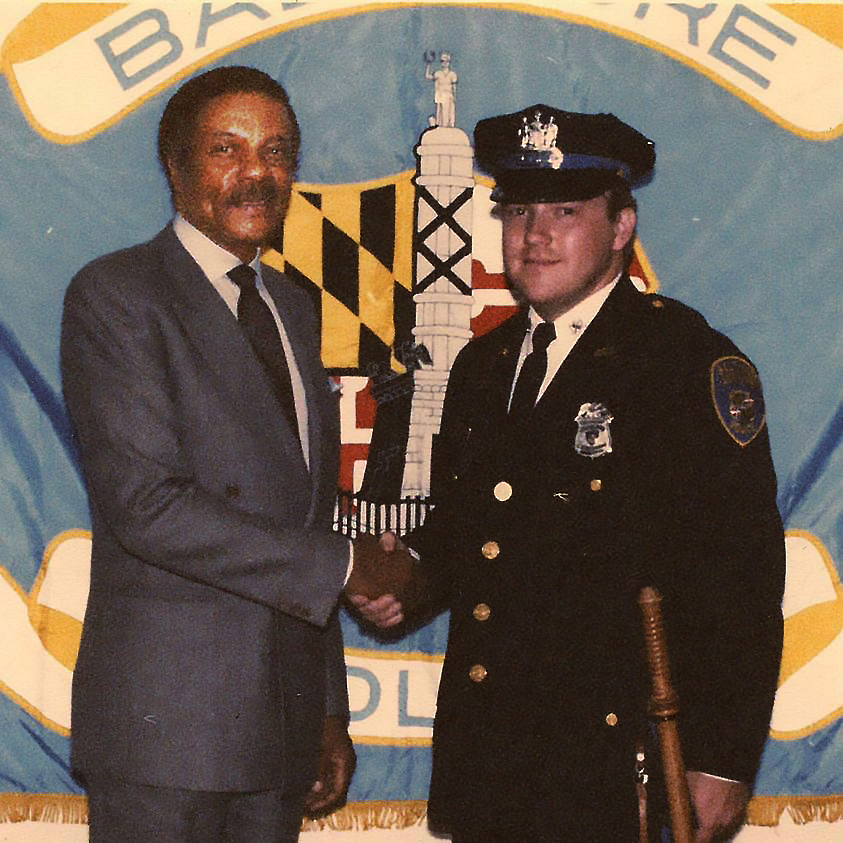
David Crouse with Bishop Robinson

EXPLANATION: The underlining indicates matter added by amendment.
CITY OF BALTIMORE
COUNCIL BILL 09-0146R
(Resolution)
Introduced by: Councilmembers Conaway, D’Adamo, Kraft, Middleton, Young, Clarke, Welch,
Henry, President Rawlings-Blake, Councilmembers Curran, Holton, Branch, Spector, Reisinger
Introduced and read the first time: September 14, 2009
Assigned to: Public Safety and Health Committee
REFERRED TO THE FOLLOWING AGENCIES: Police Commissioner
A RESOLUTION ENTITLED
1 A COUNCIL RESOLUTION concerning
2 Investigative Hearing - Baltimore City Auxiliary Police Unit
3 FOR the purpose of requesting the Baltimore Police Commissioner and the Coordinator of the
4 Auxiliary Police Unit to report to the City Council on the historic and current use of
5 Auxiliary Police in Baltimore City, requirements for service, training program components,
6 and any plans for expansion in size and deployment of the Unit.
7 Recitals
8 The Reserve Police Officers Association, a leading association for reserve, auxiliary, and
9 special law enforcement officers, reports that reserve law enforcement has been in existence
10 before the concept of modern policing took hold in the mid to late 19th century. In the 1940s,
11 many communities across the United States, including Baltimore City, created volunteer
12 auxiliary police units to provide law enforcement services to communities that had lost
13 manpower to the military and needed extra protection during the war.
14 The Public Local Laws provide for the creation of Baltimore City’s Auxiliary Police Force:
15 “to be used only to render assistance to the Police Department in service functions including, but
16 not limited to, traffic, communications, and clerical duties. The purpose of the Auxiliary Police
17 Force is to relieve the regular police personnel for law enforcement duties.” The unit has
18 consistently comprised 40 volunteer members who assist the Baltimore Police Department
19 mainly in crowd control at sporting and other special events.
20 As is evidenced by the Association, “the future of reserve law enforcement is one of growth.
21 Across the U.S. and the world, law enforcement agencies are looking to reserve law enforcement
22 to supplement, but not replace, career police services”. Los Angeles, California, Phoenix,
23 Arizona, and Dallas, Texas are in the forefront of the movement. In Los Angeles, Reserve Unit
24 activities include crosswalk enforcement, registration enforcement, front license plate
25 enforcement, vehicle lighting enforcement, and vehicle impound assignment.
26 In Phoenix, officers in the Reserve Division receive academy training, are issued police
27 equipment, including firearms, are paid for court time and receive workers’ compensation
28 insurance. These officers, who are required to work at least 16 hours a month but often
29 contribute much more time, are given the opportunity for advancement. Following a good
Council Bill 09-0146R
- 2 -
1 performance as a patrol officer and the successful completion of the requisite selection
2 processes, reserve officers may advance to detective or other specialty positions such as
3 motorcycle officer, training officer, or helicopter pilot.
4 For over 50 years, the Dallas Police Reserve Battalion has worked as an integral part of the
5 Dallas Police Department. Started as a group of citizens who assisted officers, today it has
6 evolved into a group of men and women who work in the same capacity as full-time officers.
7 The Reserve Officers must go through a year of training and maintain the same Texas Basic
8 Peace Officers License as full-time officers. The Dallas Police Department invests over $2,000
9 dollars on each recruit and expects a good faith commitment of at least 2 years of service.
10 As the fight against crime places on sworn officers increased demands, driven by more
11 sophisticated and better-armed criminals, and as the urgency of maintaining homeland security
12 mounts, the role of the Auxiliary Police needs to be revisited. It needs to be determined if
13 Baltimore’s Auxiliary Police Force is being utilized to its fullest potential in serving and
14 protecting the citizens of Baltimore.
15 NOW, THEREFORE, BE IT RESOLVED BY THE CITY COUNCIL OF BALTIMORE, That the
16 Baltimore Police Commissioner and the Coordinator of the Auxiliary Police Unit are requested
17 to report to the City Council on the historic and current use of Auxiliary Police in Baltimore
18 City, requirements for service, training program components, and any plans for expansion in size
19 and the deployment of the Unit.
20 AND BE IT FURTHER RESOLVED, That a copy of this Resolution be sent to the Mayor, the
21 Baltimore Police Commissioner, the Coordinator of the Auxiliary Police Unit, and the Mayor’s
22 Legislative Liaison to the City Council.


Is Our Auxiliary Police Happy?
Variety of Opinions Found
Sun Paper 1945
Hamilton R. Atkinson police Commissioner believes it members of the auxiliary police are happy in their work. Some auxiliary captains such as Jay Curtis Joyce of Northwestern district say the volunteers are enthusiastic about their work and their morale is fine. A resigned auxiliary Capt. Charles Lee Selden Ridge of the Eastern district says no they didn't get what they had been promised reimbursement for their uniforms.
Feel work is Ended
Others like George F Fells, 3606 Marmon Ave. a Sgt. feel their work is ended. Now that the war is over and the city should provide an adequate police force without volunteers. Another Sgt. says that many of the men feel they are getting what they are worse – nothing. And it all comes back to the original complaint by Ms. Mildred colander, who in a letter in the form of the even son said that the men were dissatisfied, that many of the auxiliaries had resigned and that they had been promised reimbursement for their uniforms.
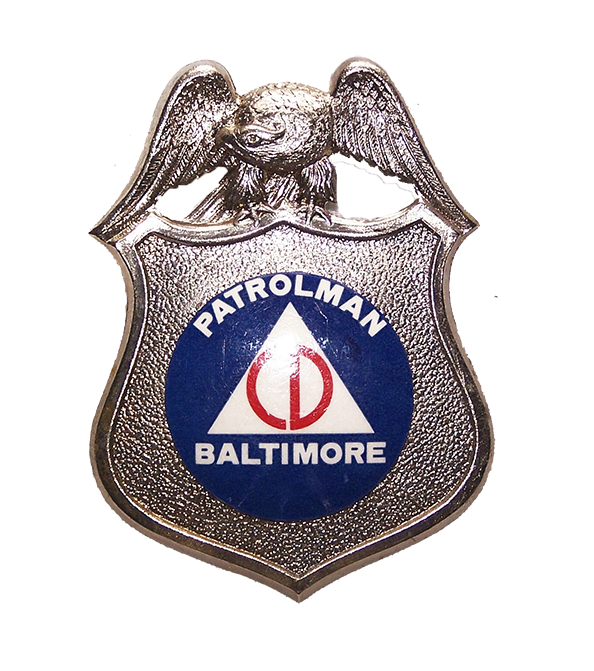
Uniform cost about $14
The uniforms in question cost each of the policeman about $14 being divided into costs: hat and hat device $4.90 shirt from a $1.95 to $3.95 pants from $6-$7 and black-tie $.75 it would add it that the men all had their own black shoes and that the pea coat's which cost about $15 was paid for usually or at least partially by the Police Department.
Many opinions on Volunteers
Disagreement found an attitude of the Auxiliary Police. Some of the viewpoints of the Auxiliary Policemen themselves follow. Lieut. Donald McNeil 1541 Windemere Ave. – the biggest question now is that the men are on the fence and don't know what to do. They don't know whether they are really needed and would like a formal statement from the Police Department telling them one way or the other.
Aren't really Enthused
We don't want to keep one unless we are of some help. Many of the men aren't really enthused about doing regular police work and would like to stop. However, I don't think the majority ever expected any return on their uniform outplays. It was made clear that they wouldn't be reimbursed by the Police Department if they purchase their own uniforms. Too many expected to get a commission but didn't get them many – about 35% – have dropped off because of this interest and no satisfaction.
Signed for Duration
George F Fells, 3606 Marmon Ave. a Sgt., there has been a lot of griping about paying for the uniforms in the past, but I think everyone has gotten over it. Part of our equipment was paid for by money raised in social fund drives. However, now I don't think we should continue as a force. We signed up for the duration, and I feel it is up to the city to provide adequate police protection. To the regular police – now that the war is over – will represent an interference into their everyday affairs.
Quit Six Months Ago
Charles Lee Seldomridge, 2505 Eastern Ave. a resigned And – I quit about six months ago and because I was getting nothing for a whole lot of time and effort. We were told in the Eastern District that we would be reimbursed for uniforms, but up until that time I left, we had gotten actually nothing for them. They didn't even give us a decent badge to where – some old tin thing – so most of the men bought their own. After they told us to go ahead and establish means of raising funds they refused to let us use the name of the auxiliary police in connection with fundraising parties. It took by far too much time for I was spending at least two nights a week on the street. In addition to putting in many hours on office work at home.
Was asked to Quit
Raymond W Royston, 609 Macon St. – a rank man who left about six months ago – I was asked to turn in my equipment because I was this interested. About that time was working overtime in war work and couldn't attend many of the regular sessions, so they sent me a letter saying I was this interested and asked me to turn in my equipment. So I turned in my armband helmet badge and all of which were given me and the key, which I had purchased personally. We bought the keys, but we still had to turn the men. What happened to the money for them? I don't know. I joined originally to serve primarily in emergency cases when they feared air raids, but I'm not a policeman and don't want to be one. We were partially reimbursed for RP coats by fundraising affairs. I paid for my uniform, but it is any good to me anymore.
Feel city should Pay
Crawford L Smith, 3709 Marmon Ave. – a rank man what actually outlay we made for our uniforms didn't amount to much, and most of us were glad to do it, and the six or eight hours a month that we put in would hardly justify the city paying for uniforms for us. RP jackets which were most expensive were paid for by subscription. See Edward Sandler 4118 Oxford Ave., another rank man when they kick me out. I'll leave. We didn't understand we were to be reimbursed. Our insurance has been paid for. And I understand a dance is to be held, and the proceeds to go to war dance arts.
No Reimbursement Promise
J Curtis Joyce 5300 Wayne Ave., a captain – those who wanted to stay on and really work is still with us and probably will be until they are no longer needed. Those who joined for the glory of it, and to wanted a chance to report the neighbors either left voluntary or were gotten rid of. After it was decided that the men should wear uniforms – but we didn't demand it – we suggested that the money is raised by outside means in each district, but did not promise to reimburse them all. Samuel Becker, a resigned auxiliary officer in the northern district – I figured the war was over and that was plenty.
Many Men are Griping
Meyer H Harasser, 4402 Fernhill Ave. – a Sgt. – many men are griping because they have not been given anything concrete – nothing except a pat on the back. They figured that if they were worth anything, they would be given something real. However, the Police Department never made any promise to us that they would reimburse us, and there is nothing they can do about it. We were given to understand that we could try means of raising funds for equipment, but nothing definite. The government employee who is in the ranks said that he thought the state should pay for the insurance.
Blame Estimate Board
Another man in the ranks who asked that his name not be used said that although the Police Department didn't and couldn't pay for the uniforms the board of estimates would say they were going to support us while our representative was there and then turned against us. The minute our backs were turned. It isn't the fault of the Police Department at all, but the board of estimates. Commissioner Atkinson earlier this week said Baltimore auxiliary police have never been promised that their activities would be financed by the Police Department because the department has no funds or means to finance them. He also explained the Police Department has an insurance set up in which men of the regular department or auxiliary may take out insurance at a very small cost. However, he emphasized the insurance is not compulsory, and that no man is obligated to take out a policy.

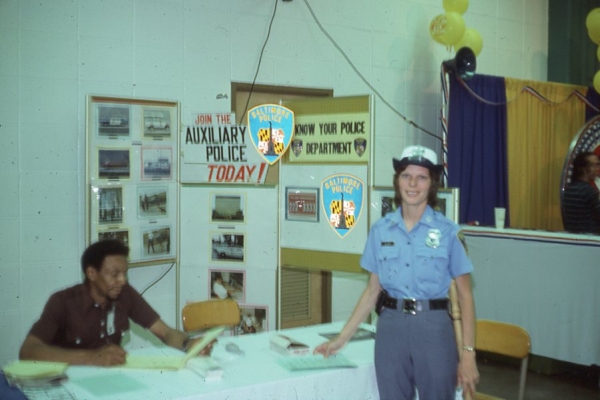
Courtesy Ret Lt Robert Wilson
Auxiliary Police Uniform
Keep Auxiliary Police
Grand Jury Purposes
Atkinson Is Opposed Sun Paper 1945
Commissioner sees no need for a reactivation of a wartime force - Says department could use 400 or 500 more sworn policemen.
Reactivation of the wartime auxiliary police force was recommended yesterday by the grand jury but was immediately opposed by Hamilton R. Atkinson, Commissioner of police, who said there was no need for such action, even though his department could use for 500 additional regular policeman
No Big Postwar Increase In Crime Atkinson Asserts
Hamilton R. Atkinson Commissioner of police said last night that he saw no need in the reactivation of the auxiliary police as proposed by the grand jury, but added that his department could use 400 to 500 additional regular policeman.
I see no real need for reestablishing the auxiliary police Commissioner Atkinson said there has been no great increase in major crimes here since the end of the war. We've been very fortunate. Police Department statistics have revealed that the number of burglaries, larcenies, and robberies, committed here from September 1 through November 18 was 70% greater than those committed during the comparable period last year up to September 28 however, five fewer murders had occurred this year than last.
Regular Versus Auxiliaries
"I would rather have 200 regular policemen than 1500 auxiliaries". Commissioner Atkinson said, and I say that without meaning to disparage the work of the auxiliaries during the war. He said that the regular department had been undermanned for years. At present, the personnel is limited by law to 1383 and with the exception of 37 vacancies being held open for the returned serviceman. This complement now is filled. He said.
Authorization for up to 450 additional policemen can be given jointly by the Governor and Mayor the Commissioner said. He said however that he has never requested this authorization from them. Nor does he immediately contemplate doing so.

Second String
Plan to Reorganize City's Auxiliary Police Unit Has Some Officers Feeling Anxious
By Jeffrey Anderson | Posted 1/21/2009
For more than a quarter of a century, the Baltimore Auxiliary Police Unit has supplemented law enforcement by directing traffic and controlling crowds during parades and major events. Now, the volunteer unit is the subject of a strategic overhaul that Baltimore City Police Department officials say will add to the unit's range of functions so auxiliary officers can be better utilized. The unit is in the midst of moving from under the auspices of the department's Administrative Bureau to its Operations Bureau. The department says the unit will be reorganized and officer training more standardized than it has been in the past.
"How did you hear about this?" asks an auxiliary lieutenant who answers the phone at the unit's offices on the 7th floor of police headquarters. "It's supposed to be hush-hush."
The unit's 30 some-odd volunteer members are required to re-apply for their positions, receive new training, submit to polygraph tests and a background check, and get fingerprinted, regardless of rank or years of service.
Auxiliary police dress like regular police, but have a blue stripe down the side of their pants. You'll see them out directing traffic on a 95-degree day at Camden Yards, or on a 35-degree day at M&T Bank Stadium. They work the BookFest, HonFest, and the MLK Day March. They carry badges marked "Auxiliary." Though they are department trained--40 to 60 hours versus six months for regular officers--they are not sworn, officers. And though they carry mace, batons, and police radios, and wear bulletproof vests, they do not carry guns.
On Jan. 13, police commanders told the unit of the overhaul, according to two sources who were at the meeting. Many had re-applied just three months ago.
"They need to stop trying to tear us down," says veteran Auxiliary Sgt. Wennie Gibson-Watts. "If not for us, the city would be paying $35 an hour for police to work the ballgames." But that might be part of the problem. Gibson-Watts and others say city police resent them as a drag on overtime, and that police commanders have threatened to retaliate against auxiliary officers who talk to the media. Promotions also have been halted, she says, and the last two training classes have been held back. "We don't even get a thank you," she says.
All aspects of the unit are up for review, says Police Agent David Simmons of the Administrative Bureau, pointing to inconsistent training and qualifications of auxiliary officers over the years. "This comes straight from the top," Simmons says, referring to Police Commissioner Frederick Bealefeld. "It's a vision the commissioner has with the full support of City Hall."
Mayor Sheila Dixon declined numerous requests for comment on the reorganization. Instead, she offers a prepared statement: "The Auxiliary Police provide a valuable service to the City. These city volunteers are a force multiplier that supports the mission of the Baltimore Police Department." A spokesperson for Council President Stephanie Rawlings-Blake says she was not aware of the plans to revamp the auxiliary unit and at press time had no further comment.
Police spokesman Anthony Guglielmi confirms the reorganization but insists the unit is not on the chopping block. "Commissioner Bealefeld is always looking to keep the knives sharp and the machine oiled," Guglielmi says, adding that the goal is to grow the unit, which is currently inactive. But he declined to offer specifics: "This is not really fleshed out yet."
Crime deployment at malls and shopping centers is one way a re-vamped auxiliary unit can be useful, says Col. Stephen Davis of the Baltimore Police Department's Technical Services Division. "They could serve as our eyes and ears."
Court records indicate the auxiliary unit is ripe for examination. A recently trained applicant, Robert S. Keene, was arrested and charged in December with second-degree rape. Unit member Carl A. Brunner says he was suspended indefinitely after his arrest in September for drug possession. (The state declined to prosecute.) Another member of the unit, who has criminal convictions that date back to at least the early 1990s, and who disclosed her record when she joined the unit, is claiming discrimination and harassment by a commanding officer who disclosed her private health information to others on the unit.
Internal e-mails obtained by City Paper paint a murky picture of the unit. "[It] is looked at with a mixture of disdain on one hand and confusion on the other because they don't know what to make of us," reads an August 2008 e-mail from an auxiliary officer whose status City Paper was not able to determine. "I had members of the CIA and the NSA at a dinner party [express] the universal misconceptions that auxiliary is a bunch of semi-retarded wing nuts that want to wear a uniform and feel important and the truth is I don't completely

Examples of Some Badges from Over the Years

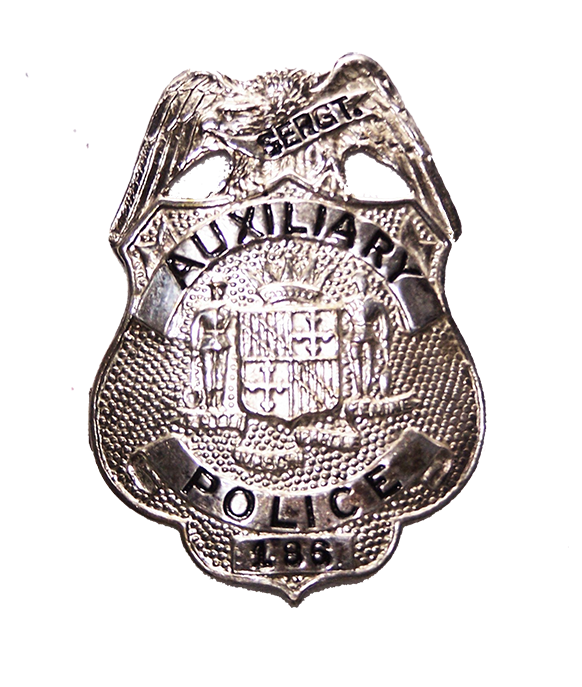
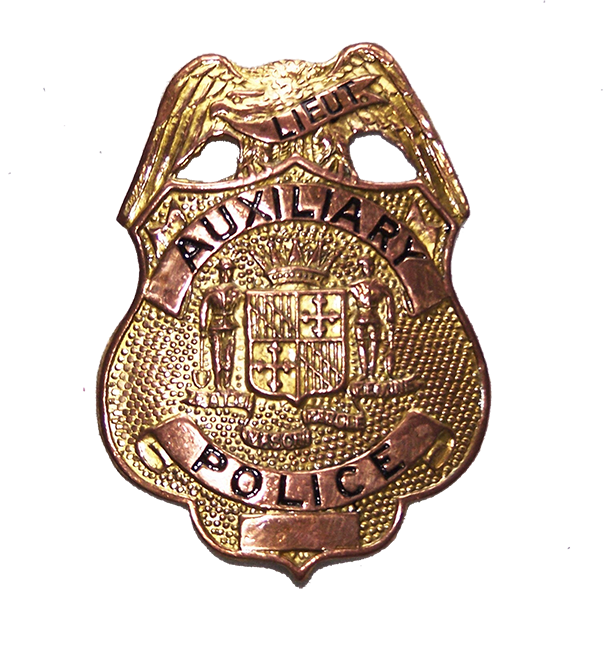
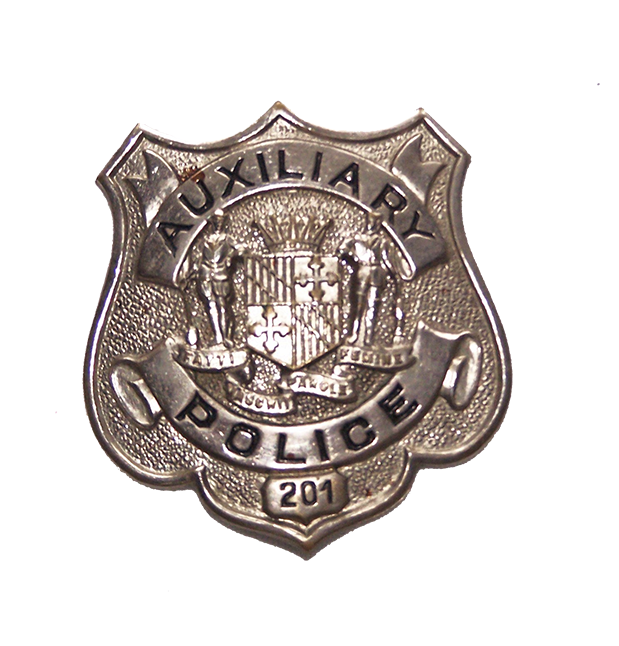
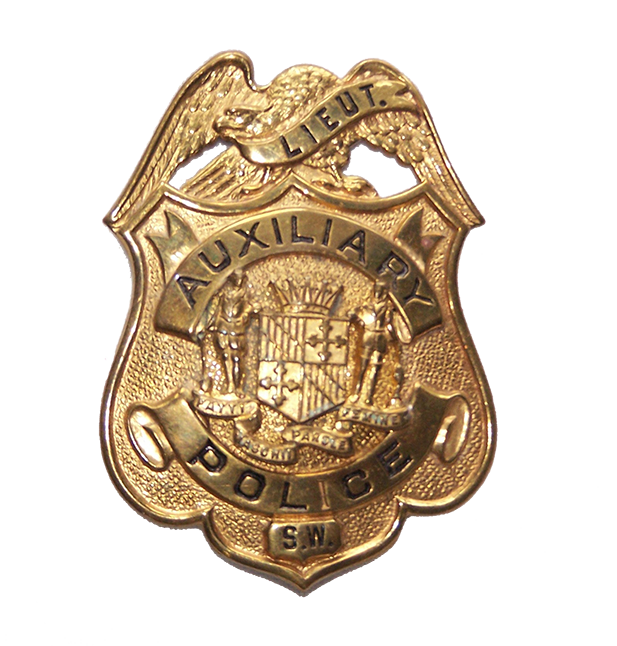


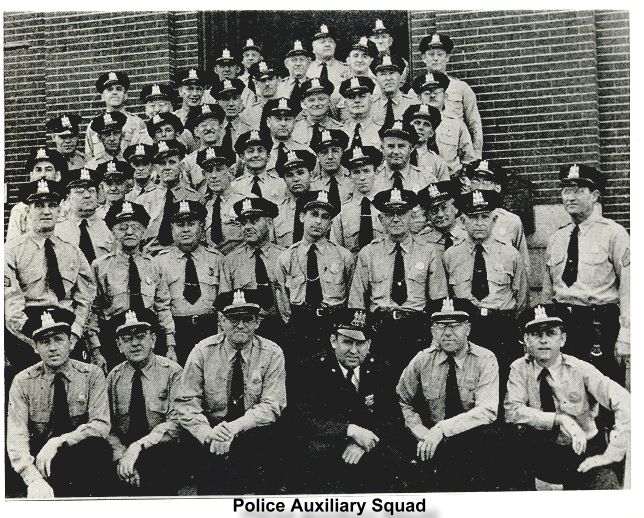
The Auxiliary Police was also Segregated into White and Black Squads
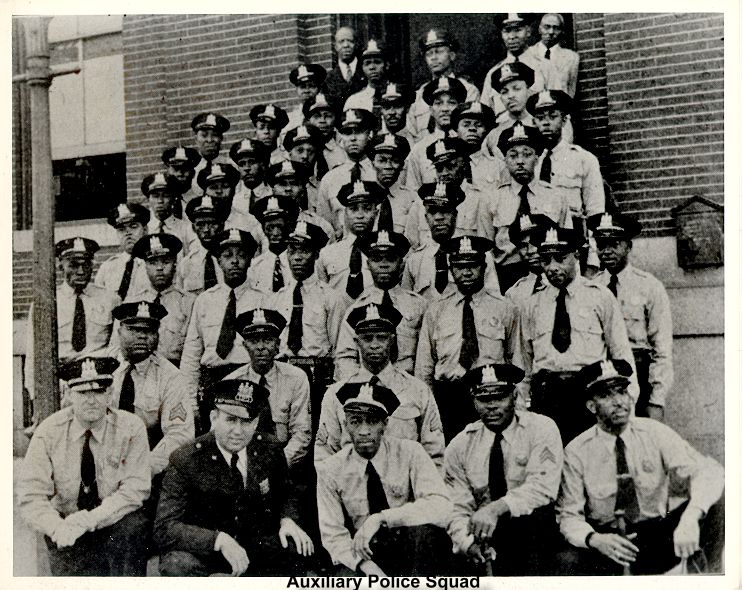
The Auxiliary Police was also Segregated into Black and White Squads
Integration wouldn't take place until 1966 in the Baltimore Police Department and the Auxiliary Police began in 1941 after Pearl Harbor, so we had about 25 years of a segregated auxiliary police force, still, the men worked together as is evident from the following photograph
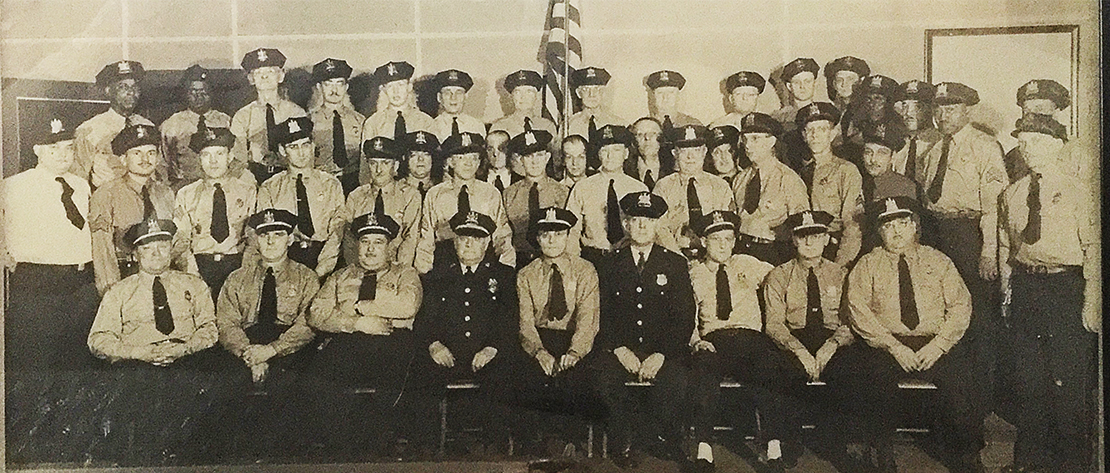
Courtesy Officer John Heiderman Retired

South Baltimore Neighborhoods and Businesses Team Up to Fund Bikes for Auxiliary Police
March 14, 2016
The Baltimore Police Department Auxiliary Unit, a volunteer organization that assists the Baltimore Police Department (BPD), now has new bikes thanks to South Baltimore. Last year, the Auxiliary Unit began a fundraising effort in hopes of purchasing new bikes for the launch of a bike patrol.
The fundraising efforts were successful as the unit received a $1,000 donation from the Federal Hill Hospitality Association (FHHA), a $333 donation from SouthBMore.com, and $250 donations from the Federal Hill Neighborhood Association (FHNA), Federal Hill South Neighborhood Association (FHSNA), Key Highway Community Association, Otterbein Community Association, Riverside Neighborhood Association (RNA), and South Baltimore Neighborhood Association (SBNA).
Three new bikes were purchased last month at Race Pace Bicycles in Federal Hill, where the unit received a discount on its purchase, and Federal Hill’s Duo Signage + Graphics supplied signage for the bikes. Extra funding is still available from the effort for future repairs and maintenance of the bikes.
The bike patrol will give the Auxiliary Unit increased accessibility in areas like parks and alleys, as well as during times of traffic congestion. It will also help them combat quality of life issues in South Baltimore and throughout the city.
The Auxiliary Unit noted that though the bikes were funded by the South Baltimore community, they will be used to benefit the entire city. The program launched on Saturday as two officers were on patrol during the Federal Hill Irish Stroll.
The Auxiliary Unit provided more than 2,500 hours of labor to the BPD in 2015.

Auxiliary Sargent John Ebert and Auxiliary Agent Matt Urso

Auxiliary Sargent John Ebert


POLICE INFORMATION
If you have copies of: your Baltimore Police Department Class Photo, Pictures of our Officers, Vehicles, Equipment, Newspaper Articles relating to our department and or officers, Old Departmental Newsletters, Lookouts, Wanted Posters, and or Brochures. Information on Deceased Officers and anything that may help Preserve the History and Proud Traditions of this agency. Please contact Retired Detective Kenny Driscoll.
This email address is being protected from spambots. You need JavaScript enabled to view it.

NOTICE
How to Dispose of Old Police Items
Please contact Det. Ret. Kenny Driscoll if you have any pictures of you or your family members and wish them remembered here on this tribute site to Honor the fine men and women who have served with Honor and Distinction at the Baltimore Police Department. Anyone with information, photographs, memorabilia, or other "Baltimore City Police" items can contact Ret. Det. Kenny Driscoll at This email address is being protected from spambots. You need JavaScript enabled to view it. follow us on Twitter @BaltoPoliceHist or like us on Facebook or mail pics to 8138 Dundalk Ave. Baltimore Md. 21222
Copyright © 2002 Baltimore City Police History - Ret Det Kenny Driscoll




































